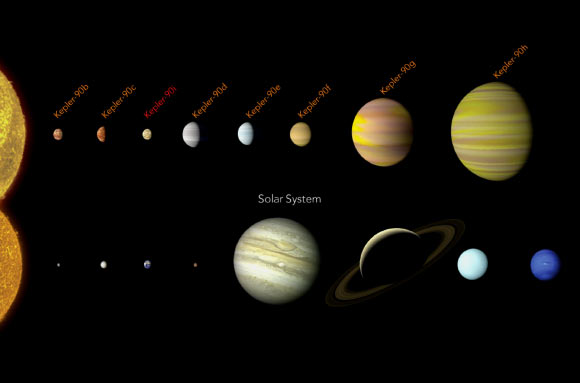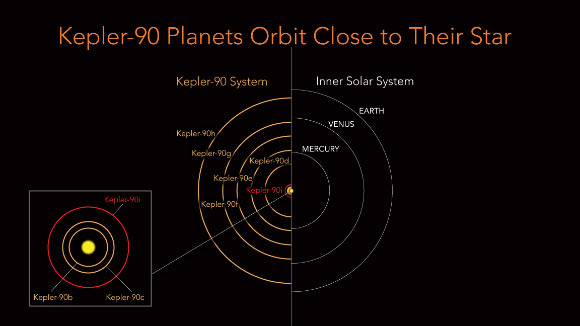A team of researchers reports the discovery of an eighth planet orbiting Kepler-90, a Sun-like star approximately 2,545 light-years from Earth in the constellation Draco. Their work will be published by the Astrophysical Journal and is available online at arXiv.org.

The Kepler-90 planets have a similar configuration to our Solar System with small planets found orbiting close to their star, and the larger planets found farther away. In the Solar System, this pattern is often seen as evidence that the outer planets formed in a cooler part of the system, where water ice can stay solid and clump together to make bigger and bigger planets. The pattern we see around Kepler-90 could be evidence of that same process happening in this system. Image credit: NASA / Ames Research Center / Wendy Stenzel.
The newly-discovered planet, dubbed Kepler-90i, is a hot, rocky planet about 1.3 times the size of Earth.
It orbits Kepler-90 (also known as KOI-351, KIC 11442793 and 2MASS 18574403+4918185) once every 14.4 days and is so close to the star that its average surface temperature is believed to exceed 800 degrees Fahrenheit (427 degrees Celsius).
The outermost planet in this planetary system, Kepler-90h, orbits at a similar distance to its star as Earth does to the Sun.
“The Kepler-90 system is like a mini version of our Solar System,” said Dr. Andrew Vanderburg, an astronomer at the University of Texas at Austin.
“You have small planets inside and big planets outside, but everything is scrunched in much closer.”
The discovery came about after Dr. Vanderburg and Christopher Shallue, a senior software engineer with Google’s research team Google AI, trained a computer to learn how to identify exoplanets in the light readings recorded by NASA’s Kepler Space Telescope.
The team’s artificial ‘neural network’ sifted through the archival Kepler data and found weak transit signals from a previously-missed planet orbiting Kepler-90.
“Just as we expected, there are exciting discoveries lurking in our archived Kepler data, waiting for the right tool or technology to unearth them,” said Paul Hertz, director of NASA’s Astrophysics Division in Washington, who was not involved in the study.
“This finding shows that our data will be a treasure trove available to innovative researchers for years to come.”

Kepler-90 is a Sun-like star, but all of its eight planets are scrunched into the equivalent distance of Earth to the Sun. The inner planets have extremely tight orbits with a ‘year’ on Kepler-90i lasting only 14.4 days. In comparison, Mercury’s orbit is 88 days. Consequently, Kepler-90i has an average surface temperature of 800 degrees Fahrenheit, and is not a likely place for life as we know it. The structure of the Kepler-90’s system hints that the eight planets around Kepler-90 may have formed more spread out, like the planets in our own Solar System, and then somehow migrated to the orbits we see them in today. Image credit: NASA / Ames Research Center / Wendy Stenzel.
Kepler-90i wasn’t the only jewel the team’s neural network sifted out — in the Kepler-80 planetary system, they found a sixth planet.
This one, the Earth-sized Kepler-80g, and four of its neighboring planets form what is called a resonant chain — where planets are locked by their mutual gravity in a rhythmic orbital dance. The result is an extremely stable system, similar to the seven planets in the TRAPPIST-1 system.
The researchers now plan to apply their neural network to Kepler’s full set of more than 150,000 stars.
_____
Christopher J. Shallue & Andrew Vanderburg. 2017. Identifying Exoplanets with Deep Learning: a Five Planet Resonant Chain around Kepler-80 and an Eighth Planet around Kepler-90. AJ, in press; arXiv: 1712.05044







